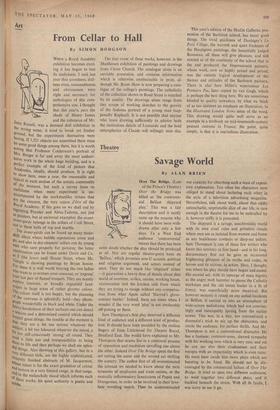From Cellar to Hall
By SIMON HODGSON WHEN a Royal Academy exhibition becomes excit- ing it has begun to lose its usefulness. I said last year that soundness, dull- ness even, reasonableness and obviousness were right and necessary for anthologies of this com- prehensive size. I thought that this year's, pace the shade of Henry James - and the substance of Mr. John Russell, was a damned dull exhibition in the wrong sense; it tried to break yet fresher ground , but the experiments themselves were boring. If 1,521 objects are assembled there must be some good things among them, but it is worth noting that Professor Coldstream's portrait of Mrs. Burger is far and away the most authori- tative work in the whole huge building, and is a Perfect example of the kind, of picture that Academies, ideally, should produce. It is right to show here, once a year, the reasonable and tYpical in each section of the artistic community of the moment, but such a survey loses its usefulness when mere experiment is un- accompanied by the workmanlike virtues that are the concern, the very raison d'être of the RoYal Academy. If this goes on we shall end by regretting Poynter and Alma-Tadema, not just as painters, but as universal examples; the avant- "ant-garde belongs in the cellars of Cork Street, not in these halls of rep and marble. The avant-garde can be found up many make- shift alleys where bubble reputations come and go, and also in dry-cleaners' cellars run by young Men who care properly for pictures; the latter combination can be found under Davis and Co. at 8 (the lower end) Sloane Street, where Mr. Iempie is showing paintings by Bryan Senior. or these it is well worth braving the two ladies who want to re-texture your overcoat, or 'express' Your last pair of flannel trou,sers. They are mainly sombre interiors, or broadly organised land- al3es in large areas of rather gloomy colour. ' he colour itself is not happy, but the planning (I the canvases is splendidly bold—they photo- 8raPh wonderfully in black and white. Under the ileavY-handedness of their surfaces one can detect tension and a determined control which should 4°retell great things; the trouble at the moment is at they are a bit too serious whatever the ,3u.bjeel, a bit too laboured whatever the mood, a olt too self-consciously 'strong' all round. They niced a little sun and irresponsibility to bring tueln to life and then perhaps we shall see splen- did things. Also showing at this gallery, but in a l'erY different style, are the highly sophisticated, Ininutely finished abstracts of M. Jacquemon, Whose talent is for the exact gradation of colour and texture in a very limited range; in that range, _411.d in the melancholy mood which informs each °I these works, his quiet authority is poetic and The real event of these weeks, however, is the Matthiesen exhibition of paintings and drawings from Christ Church. The catalogue alone is an enviable possession, and contains information which is otherwise unobtainable in print, al- though Mr. Byam Shaw is now preparing a cata- logue of the college's paintings. The catholicity of the collection shown in Bond Street is matched by its quality. The drawings alone range from tiny scraps of working sketches to the gravity of the Sodoma portrait of a young man (sup- posedly Raphael). It is not possible that anyone who loves drawing sufficiently to admire both the meticulous details of Leonardo and the bold atmospherics of Claude will willingly miss this. This year's edition of the Hazlitt Galleries pro- motion of the Barbizon school, has many good things. The vivid quickness of Daubigny's Le Petit Village, the warmth and quiet freshness of the Harpignies paintings, the beautifully judged Rousseau, all these will give pleasure, and will remind us- of the continuity of the school that in the end produced the Impressionist painters, whose work, now so highly prized and priced, was the entirely logical development of the themes and attitudes of the Barbizon painters. There is also here Millet's watercolour Les Premiers Pas, later copied by van Gogh, which is perhaps the best thing here. We are sometimes blinded to quality nowadays, by what we think of as too insistent an emphasis on illustration, in the Illustrated London News sense of the word. This drawing would quite well serve as an example in a textbook on mid-nineteenth-century peasant customs in France; the point, quite simply, is that it is marvellous illustration.




































 Previous page
Previous page